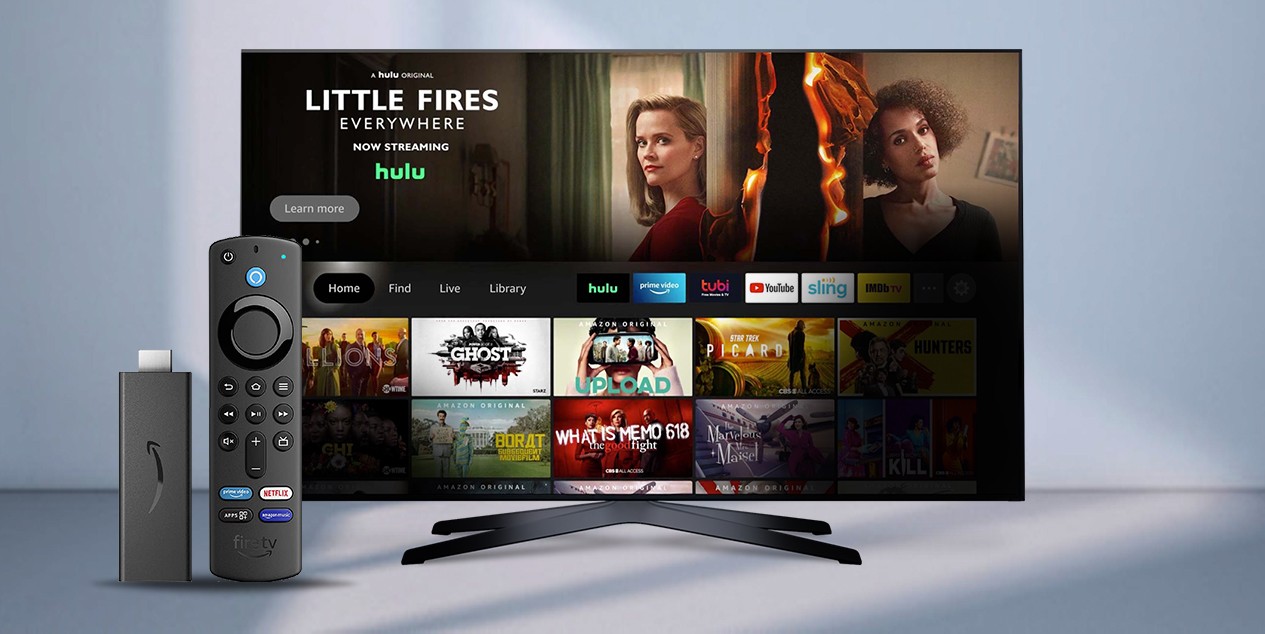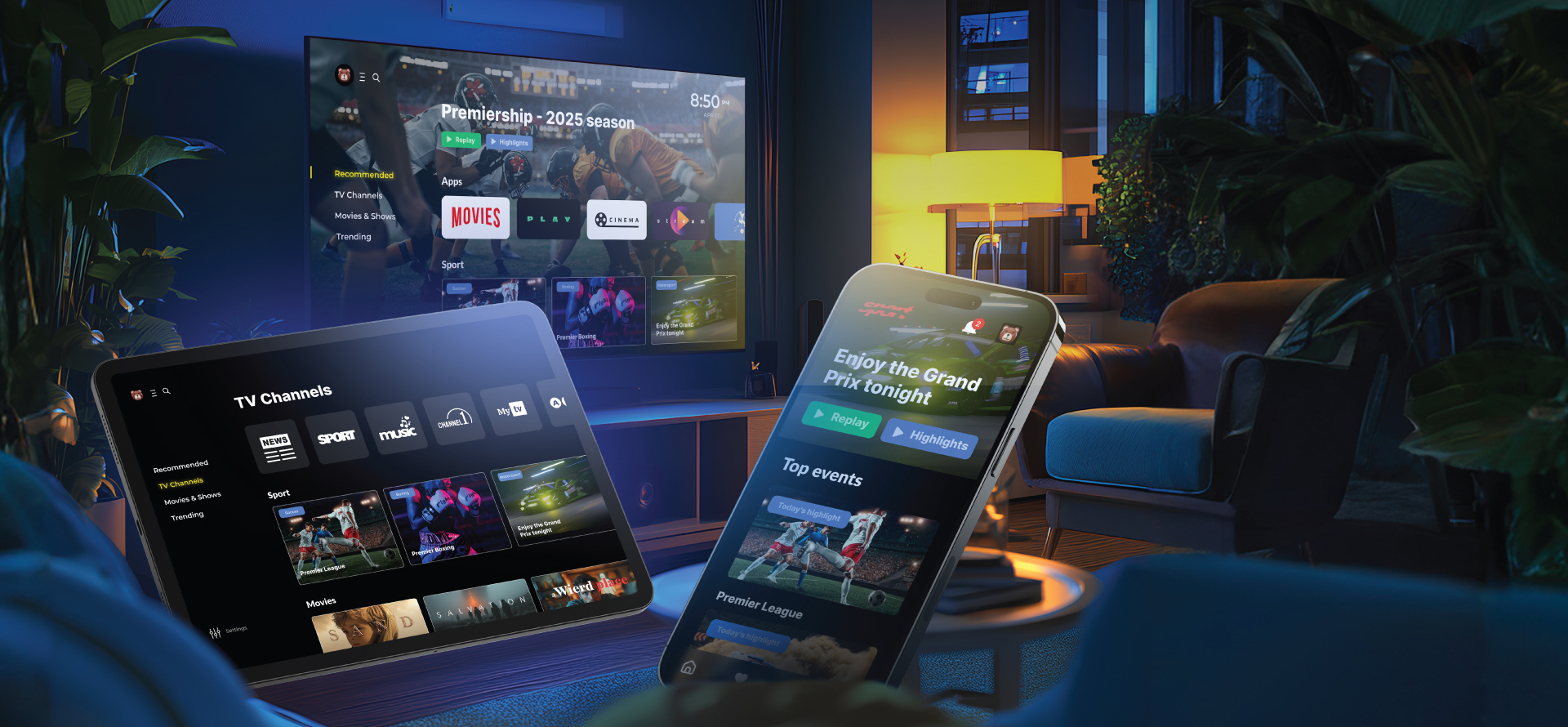The average household now juggles around 11 connected devices — nearly 7 of which have screens demanding attention. If you’re a media content distributor, that means your audience isn’t just watching; they’re multitasking, hopping seamlessly between smartphones, tablets, laptops, and Smart TVs. The challenge? Making sure your content doesn’t just appear everywhere, but engages seamlessly across all these screens.
Welcome to multi-screen app development, where the difference between a captivated audience and a distracted one lies in crafting experiences tailored for every device. Ready to master this multi-screen dance? Let’s dive in.
The multi-screen development challenge
Multi-screen development isn’t simply about pushing your app to multiple platforms; it’s about creating unified yet optimized experiences across an array of distinct devices. Each screen, whether it’s a smartphone, tablet, laptop, or TV, presents unique screen sizes, operating systems, and input methods. The intuitive swipe on a smartphone, precise mouse clicks on a laptop, or simple remote interactions on a Smart TV all require thoughtful, device-specific design.
Achieving this requires a careful balance:
- Consistency: Your brand and core functions must remain clear and recognizable across every device.
- Complementarity: Devices should interact fluidly, like effortlessly casting content from your phone to your TV.
- Continuity: Users expect seamless transitions, enabling them to pause content on one device and resume effortlessly on another.
A well-executed multi-screen strategy also opens the door to greater monetization. Consider Reebok’s experience: a multi-screen ad campaign boosted their conversions by 131%. However, leveraging these opportunities also means tackling complex ad formats and analytics integrations.
Technical challenges further add to the complexity. Ensuring content protection across various DRM systems, like Google Widevine for Android devices and Microsoft PlayReady for Smart TVs, is crucial. Additionally, users expect flawless streaming quality across all devices, making performance optimization essential.
Finally, navigating the diverse submission guidelines of different platforms, such as Apple’s App Store, Google Play, and Roku, among others, requires careful attention to detail.

Step-by-step multi-screen app development process
Creating a successful multi-screen app involves careful planning and execution. Here’s how to go from idea to launch efficiently:
Step 1: Strategy and planning
Define your audience and prioritize key platforms. Will your users primarily be on mobile, web, or Smart TVs? Choose between native and cross-platform development based on your budget and flexibility needs. Clearly map essential features for each platform to ensure clarity from the start.
Step 2: UX/UI design
Adapt your user experience uniquely for each device while maintaining brand consistency. For example, a TV interface needs simple navigation and large text, while mobile apps rely on intuitive touch gestures. Design for emerging form factors like foldable devices as needed.
Step 3: Tech stack and architecture
Select a tech stack and architecture emphasizing efficiency and scalability. You may decide between native or cross-platform frameworks (e.g., React Native, Flutter). Opt for modular architectures to maximize code reuse and simplify future updates.
To make this work long-term, many teams turn to custom video solutions that streamline back-end logic, integrate DRM, and support multi-platform deployment from a single, centralized core.
Step 4: Development and integration
Execute parallel development for different platforms, integrating back-end APIs, DRM solutions, analytics, and ad networks. Prioritize cross-device features like content synchronization and second-screen capabilities. Frequent communication between development teams ensures consistency.
Step 5: Testing and quality assurance
Perform extensive testing across real devices, addressing functional performance and usability across screens. Test thoroughly for seamless multi-device interactions, smooth streaming quality, and platform-specific quirks. Conduct regression testing and UX consistency checks frequently.
Step 6: Deployment and launch
Prepare carefully for platform-specific submission processes and guidelines (Apple App Store, Google Play, Roku). Plan phased launches to manage complexity. Once live, monitor user feedback and analytics closely to refine and evolve your app continuously.
Pitfalls and common issues in multi-screen development
Even with solid planning, multi-screen app development often runs into roadblocks. Below are real-world challenges we’ve seen trip up teams and what you can do to avoid them.
1. Inconsistent user experience across screens
A global content provider launched their app on mobile and Smart TVs, but the designs were handled by different teams. The result? Users couldn’t find the same features, and navigation behavior varied wildly between devices.
Fix: Use a shared design system across platforms. Conduct regular cross-team design reviews to catch inconsistencies before they go live.
2. Assuming devices behave the same
One client learned the hard way that Android TV doesn’t treat video autoplay like iOS or web. Their app auto-paused on mobile but kept playing on TV, confusing users.
Fix: Maintain a device behavior checklist during planning. Test early across platforms to validate assumptions about navigation, inputs, or autoplay logic.
3. Performance bottlenecks on TVs or older tablets
We’ve seen rich animations and heavy UI elements that look great on iPhones crash Smart TVs with limited GPU power.
Fix: Design with low-spec hardware in mind. Implement adaptive layouts and performance fallbacks (e.g., static images instead of video previews on slower devices).
4. App Store setbacks due to policy gaps
A perfectly working Roku app was rejected due to remote control navigation not conforming to Roku’s UX guidelines, even though it worked fine technically.
Fix: Don’t just code for functionality. Review app store documentation (especially for Smart TVs) early and pre-validate with test submissions if possible.
5. Rushing DRM integration
In one OTT project, DRM was treated as “just a plugin” and added right before launch. But integrating Widevine and FairPlay exposed device-specific streaming bugs that delayed the go-live by weeks.
Fix: Start DRM integration early in development. Test encrypted playback on real devices, including low-tier Androids and older iPads.
6. Cross-platform framework overreach
A team used React Native for mobile and tried extending it to Android TV. It worked until they needed custom remote navigation and adaptive video playback, which React Native wasn’t equipped to handle.
Fix: Use cross-platform frameworks smartly. Reuse business logic, but don’t force a tool into platforms it doesn’t fully support. Sometimes hybrid logic is better than forcing full unification.
7. Feature lag between platforms
A streaming service added offline viewing to their Android app but didn’t have a plan for iOS or TV. Support requests flooded in: “Why can’t I do this on my iPad?”
Fix: Create a platform rollout matrix. Prioritize feature parity for critical functionality and communicate clearly to users when something is coming soon.
8. No plan for foldables and dual screens
An Android tablet app was fine until it ran on a foldable. The layout broke, video controls disappeared, and user reviews took a hit.
Fix: Test UI scaling on foldables and large screens early. Google provides emulators and layout inspectors for this exact reason. It’s easier to build responsive layouts upfront than retrofit them later.
By grounding your dev process in real-world patterns and learning from others’ missteps, you can sidestep these common pain points. It’s not just about getting your app on more screens, it’s about getting it right on every screen that matters.
Case in point: one codebase, 13 platforms, 25 devices
We helped a major OTT provider launch a highly customizable streaming solution across mobile, smart TVs, web, and set-top boxes — fast. Thanks to smart architecture and extensive code reuse, our team cut development time and costs without compromising on performance or UX.

Cost considerations for multi-screen projects
Let’s be honest, building a multi-screen app isn’t cheap. But if approached strategically, the ROI often outweighs the upfront investment. Here’s what may shape your budget and where you can optimize:
1. Number of platforms = multiplying costs
Each additional screen, whether it’s iOS, Android TV, Roku, or web, adds complexity. Some backend and logic can be reused, but UI, integrations, and QA scale with every platform.
Tip: Start with the platforms that cover 80% of your audience. Expand once traction and revenue prove the value.
2. Native vs. cross-platform development
Going native offers deep customization but means building (and maintaining) separate apps. Cross-platform frameworks like Flutter or React Native reduce duplication, but may require compromises or premium SDKs.
Tip: Don’t chase “one codebase fits all” unless the framework truly supports your use case across mobile, TV, and desktop.
3. UX & design across screens
Designing for phones, tablets, TVs, and maybe foldables means more than resizing layouts. It’s a different interaction logic, content prioritization, and accessibility.
Tip: Build a flexible design system early. It keeps UX aligned while reducing hours spent redesigning from scratch.
4. Testing & optimization
Real device testing is non-negotiable. Every platform demands functional testing, performance tuning, and UI adjustments. Older TVs and budget tablets can become bottlenecks.
Tip: Budget for QA early. It’s cheaper to catch a platform-specific bug in testing than in user reviews.
5. Ongoing maintenance
Multi-screen apps need multi-front maintenance. OS updates, new devices, and store requirements evolve constantly. A modular architecture and centralized backend can reduce the long-term support load.
Tip: Use usage analytics to prioritize updates. If 80% of users are on mobile, don’t overinvest in rarely used TV apps unless there’s growth potential.
6. Scope control = budget control
You don’t need every feature on every device at launch. A smartwatch app doesn’t need full media management.
Tip: Define platform-specific MVPs. Launch, validate, then scale features based on feedback and usage.
Multi-screen app development is not only about staying on the wave of technical trends, but it’s a response to how people consume content today. From smartphones on the go to smart TVs at home, your audience expects fluid, familiar experiences across every screen they touch.
We’ve covered fragmented platforms, platform quirks, scaling UX, performance trade-offs, and the price tag that comes with doing it right. But here’s the upside: the brands that succeed across devices don’t just adapt. They lead.
Whether you’re launching a new OTT platform or expanding a streaming app to TVs and tablets, the right approach makes all the difference. Prioritize what matters most for your users. Choose the tech that scales with you. And don’t underestimate the value of partnering with teams that have already navigated this terrain.
Because in the end, multi-screen isn’t about being everywhere. It’s about being everywhere that matters, and delivering an experience people want to come back to.
How we can help
Planning to take your video service beyond just mobile and desktop? We build apps that feel native on every screen — from iPhones and tablets to Roku, Tizen, WebOS, and Android TV, set-top boxes. No missed opportunities, just seamless, scalable multi-screen app development that gets you in front of your audience, wherever they hit play.

























